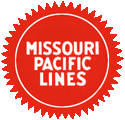
















In 1967, the railroad operated 9,041 miles of road and 13,318 miles of track, not including DK&S, NO&LC, T&P and its subsidiaries, C&EI and Missouri-Illinois.
Union Pacific Corporation, the parent company of the Union Pacific Railroad, agreed to buy the Missouri Pacific Railroad on January 8, 1980. Lawsuits filed by competing railroads delayed approval of the merger until September 13, 1982. After the Supreme Court denied a trial to the Southern Pacific, the merger took effect on December 22, 1982. However, due to outstanding bonds of the Missouri Pacific, its full merger into the Union Pacific Railroad did not become official until January 1, 1997.
Missouri Pacific was under the control of New York financier Jay Gould from 1879 until his death in 1892. Gould developed a system extending through Colorado, Nebraska, Arkansas, Texas, and Louisiana. His son George Gould inherited control upon his father's death, but lost control of the company after it declared bankruptcy in 1915. The line was merged with the St. Louis, Iron Mountain and Southern Railway (SLIMS) and reorganized as the Missouri Pacific Railroad in 1917. Missouri Pacific later acquired or gained a controlling interest in other lines in Texas, including the Gulf Coast Lines, International-Great Northern Railroad, and the Texas and Pacific Railway.
MoPac declared bankruptcy again in 1933, during the Great Depression, and entered into trusteeship. The company was reorganized and the trusteeship ended in 1956.
By the 1980s the system would own 11,469 miles of rail line over 11 states bounded by Chicago to the east, Pueblo, Colorado, in the west, north to Omaha, south to the U.S.-Mexico border in Laredo, Texas, and southeast along the Gulf seaports of Louisiana and Texas. MoPac operated a fleet of more than 1,500 diesel locomotives, almost all purchased within the previous 10 years. Under the leadership of Downing B. Jenks, who became president and chief executive in 1961, the company became a pioneer in the early days of computer-guided rail technology. It was a major hauler of coal, grain, ore, autos, dry goods and shipping containers. At the time of its mega-merger in 1982, the MoPac owned more and newer locomotives and operated more track than partner Union Pacific Railroad.
On December 22, 1982 the Missouri Pacific was purchased by the Union Pacific Corporation and combined with the Western Pacific Railroad and Union Pacific Railroad to form one large railroad system. The new entity was called Pacific Rail Systems; though part of the Union Pacific Corporation, all three railroads maintained their own corporate and commercial identity. On December 1, 1989, the Missouri Kansas Texas and the Galveston, Houston & Henderson were merged into the Missouri Pacific after having been acquired by the Union Pacific Corporation in 1988.
By 1994 all motive power of the Missouri Pacific was repainted and on January 1, 1997, the Missouri Pacific was officially merged into the Union Pacific Railroad by the Union Pacific Corporation. UP continued to use the MoPac headquarters building at 210 N. 13th St. in downtown St. Louis for its customer service center until February 15, 2005. The former MoPac building has undergone rehab as apartments and is now known as Park Pacific.
In the streamliner era, the Missouri Pacific's premier passenger trains were collectively known as the Eagles. A variety of Eagle trains were operated, with the first such train inaugurated in 1940. These routes included the Missouri River Eagle (St. Louis-Kansas City-Omaha), the Delta Eagle (Memphis, Tennessee-Tallulah, Louisiana), the Colorado Eagle (St. Louis-Pueblo-Denver), the Texas Eagle (St. Louis to Texas), and the Valley Eagle (Houston-Corpus Christi-Brownsville, Texas).
Missourian (between St. Louis and Kansas City);
Orleanean (between Houston and New Orleans);
Ozarker (between St. Louis and Little Rock);
Pioneer (between Houston and Brownsville);
Southerner (service from Kansas City and St. Louis to New Orleans, via Little Rock);
Southern Scenic (between Kansas City and Memphis);
Sunflower (between St. Louis and Wichita); and the Texan (between St. Louis and Fort Worth).